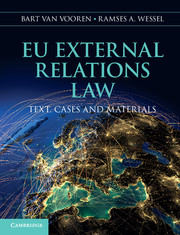Book contents
- Frontmatter
- Contents
- Table of cases
- Table of instruments and legislation
- Preface
- Acknowledgements
- List of abbreviations
- 1 The EU as a global legal actor
- 2 Instruments of EU external action
- 3 Existence of EU external competence
- 4 Nature of EU external competence
- 5 Scope and choice of EU external competence
- 6 The duty of cooperation
- 7 EU law and international law
- 8 The EU and international institutions
- 9 Common Commercial Policy
- 10 EU development policy
- 11 Common Foreign and Security Policy
- 12 Common Security and Defence Policy
- 13 The external dimension of the internal energy market
- 14 The external dimension of freedom, security and justice
- 15 The EU and its neighbours
- Index
- References
4 - Nature of EU external competence
- Frontmatter
- Contents
- Table of cases
- Table of instruments and legislation
- Preface
- Acknowledgements
- List of abbreviations
- 1 The EU as a global legal actor
- 2 Instruments of EU external action
- 3 Existence of EU external competence
- 4 Nature of EU external competence
- 5 Scope and choice of EU external competence
- 6 The duty of cooperation
- 7 EU law and international law
- 8 The EU and international institutions
- 9 Common Commercial Policy
- 10 EU development policy
- 11 Common Foreign and Security Policy
- 12 Common Security and Defence Policy
- 13 The external dimension of the internal energy market
- 14 The external dimension of freedom, security and justice
- 15 The EU and its neighbours
- Index
- References
Summary
Central issues
Once it is established that competence for the Union to act exists, we must examine the impact this will have for the Member States’ ability to act internationally. This is the question of the ‘nature’ of EU competence, and is subdivided into two main categories according to how they impact the Member States’ powers: exclusive EU competence, or shared with the Member States.
In the category of exclusive competences, we distinguish between a priori exclusivity, conditional exclusivity and exclusivity through necessity. In the first instance, EU primary law expressly states that a given competence is to be exercised by the EU alone. In the case of conditional exclusivity, Member States are pre-empted from acting when their international action may affect common rules adopted by the EU. The third is a minor sub-category of conditional exclusivity.
In the category of shared competences we distinguish between: shared pre-emptive competences, shared non-pre-emptive (complementary) powers, supplementary powers and parallel powers. In each category the scope for the EU and the Member States to act alone or alongside each other differs, depending on the fulfilment of certain conditions. Much of this chapter is focused on the first category, namely the conditions under which the exercise of a shared competence will pre-empt Member State international action, and the legal justification given by the CJEU.
- Type
- Chapter
- Information
- EU External Relations LawText, Cases and Materials, pp. 99 - 137Publisher: Cambridge University PressPrint publication year: 2014
References
- 1
- Cited by



